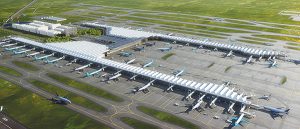Bloomberg
Mexico City’s newest airport, opening on March 21, is meant to relieve traffic at the mega-city’s main hub. The eight daily flights it will start with won’t achieve this — but that’s beside the point for President Andres Manuel Lopez Obrador. The Felipe Angeles airport, located about 50 kilometres (31 miles) north of Mexico City’s centre, is a military base that the army converted into a commercial airport in about two and a half years. It’s the first of Lopez Obrador’s large infrastructure projects to be completed, and it’s meant to demonstrate his government’s efficiency and austerity.
The airport’s shoestring budget of 75 billion pesos ($3.6 billion) is a fraction of the $13 billion project that former President Enrique Pena Nieto started and which Lopez Obrador scrapped. Its inauguration comes just in time for a referendum the president has proposed on whether he should stay for the rest of his six-year term.
The opening has been criticised as rushed — roads leading to the terminal remain unfinished and a promised train from the city is still far off.
Nonetheless, Lopez Obrador is betting its completion will help him shore up support as scandals and a weak economy dent his high approval ratings.
The project cancelled by Lopez Obrador would have completely replaced the city’s existing Benito Juarez airport, which has been plagued by congestion for decades.
The smaller-scale Felipe Angeles, in contrast, is meant only to ease the burden on Benito Juarez, where the government has said it will no longer grant new flight permits.
Lopez Obrador has cited
New York and London as
examples of cities with multiple airports that operate simultaneously and that Mexico’s capital should emulate. But Maria Larriva, a former air traffic controller in Mexico City and an investigator in aviation accidents, says this ignores the metropolis’s unique geography.
“We’ve known for 30 years that the base is not a good place for a commercial airport,†she said in an interview. Multiple studies have documented problems, she added, including high altitude — Mexico City is above 2,100 meters (7,000 feet), and this can alter how a plane performs. A nearby active volcano is another concern.
The president’s press office didn’t respond to a request for comment, but Mexican authorities argue that they redesigned the capital’s airspace last year to make Felipe Angeles more viable. The surrounding mountains still make takeoff and landing difficult, however.
“You can’t just make mountains disappear,†Larriva said. Even with only eight daily flights at Felipe Angeles, Benito Juarez will still have to suspend some operations due to safety precautions, she said — offsetting any improvements in congestion that the new airport could offer. Studies show that both airports can’t operate simultaneously at maximum capacity, she said.
The new airport’s initial flights will be mostly domestic, with one international route operated by Venezuelan carrier Conviasa to Caracas. Grupo Aeromexico SAB will have flights to and from the Mexican cities of Merida and Villahermosa starting in April, while Volaris will fly to Tijuana and Cancun.
Building Felipe Angeles saved the country 100 billion pesos (about $4.8 billion), Lopez Obrador has said.
 The Gulf Time Newspaper One of the finest business newspapers in the UAE brought to you by our professional writers and editors.
The Gulf Time Newspaper One of the finest business newspapers in the UAE brought to you by our professional writers and editors.
